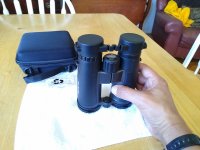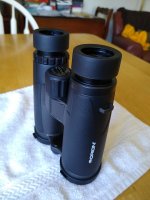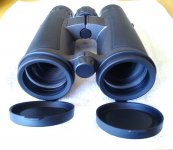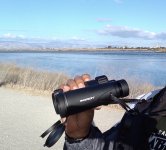As a longtime birder, I come from the land of “8x means better hand hold-ability.” In reading some recent reviews on this site, I realized that, despite my research, I had never actually owned or even tested for more than a few minutes, 10x binoculars. Since many birders swear by 10x for birding, I figured I should vet my own assumptions, and so took advantage of an insane deal on a closeout of the Orion Otter 10x42 ED binoculars, to gain a deeper understanding of what the experience of living with 10x magnification for birding was like. Oh yeah, and ED glass as well!
Wow.
The Otters are rather remarkable binoculars by multiple measures. First, the tale of the tape:
They are the lowest cost of entry into the world of Extra Low Dispersion (ED) objective lenses (on sale today for $119). The box check sounds like a wish list of alpha binocular tech:
- 42mm ED objectives
- Fully multi coated
- Phase Corrected
- Dielectric reflective prism coatings
- Magnesium alloy chassis
- Waterproof, fogproof, O-ring sealed, nitrogen purged
- Twist-up click-stop eyecaps
- Open bridge design
- 7’ close focus
- Included: Super nice clamshell case w strap, neoprene binocular strap, tethered objective covers and rain guard caps, polishing cloth
Yeah, I know, I know – a spec sheet does not alone great binoculars make. So read on…
I did back-to-back comparisons between the Otters and two of my better bins:
(1) my Swift Audubon 8.5x44 HR/5 4b(2),
(2) my Browning 8x32 roofs (excellent bins, with many positive reviews on this site);
In particular the Swifts are well known for being some of the finest center field optics ever made, which yields some interesting insights on both 10x and the nature of ED glass.
I warmed up the Otters in my yard, then put them through their paces at Charleston Slough in Mountain View CA, one of the better birding sites in the Bay Area, and a feeding zone for the Pacific Flyway.
Some observations on the Otters:
They are the perfect size for my hands. My Browning 8x32 roofs are just a bit too short to accommodate my whole hand; their length, combined with the single wide bridge, means I am constantly re-adjusting my hold to set my hands on the bins. My pinkies continually slip over the objectives. The Otters are almost an inch of useable grab-space longer, and put that to effective use.
The Otters are DENSE, not HEAVY. They weigh in at a svelte 24 oz., only a pound and a half for a 42mm binocular, a super low weight for that size. Even more, the weight is distributed over the length evenly, so it is nicely balanced, and feels lighter than it is. It does convey a feeling of density, of heft, associated with quality binoculars – just not in a manner that makes them feel heavy. I used the Otters in the field over two hours the very first day, and I only stopped because my wife called me home for dinner!
By contrast, my Brownings feel both dense AND heavy; despite its solid optics, quality materials, and small size, it simply feels really really heavy in hand (even though it is the same weight than the Otters) I simply grow weary lifting it after short periods of use.
The Otters have an unexpected, quality feel – think “Seiko Binoculars”- not Rolex, not Tag Heuer, but nice! They have a good looking, well balanced, tactile feel from the dual-density rubber armor – slightly heavier and textured for “grab-heavy” spots on the tops and sides; and smoother and lighter finish in the non-grab areas. Orion uses a slight color difference as well, darker for the heavier rubber, grayer for the smooth; subtle but noticeable, a nice design touch. No surface feels or looks cheap. The bridge adjustment movement is firm but smooth. The rotating eye-guards are free of wiggle or slop.
The only noticeable cost saving elements (gotta have at least a few of those on an insane deal, right?) are the flexi-rainguard eyepiece covers, and the tethered objective covers – both work quite well, but you can tell they were from the parts bin. The dioper adjustment is non-locking, but firm, almost difficult to move – once you set it, it’s not going anywhere. The only thing I would classify as a negative is the focuser knob resistance – the knob itself has a nice size, feel and a firm touch to turn, but the effort to do so is uneven. No grinding or mechanical distress, but as you turn the focuser, the resistance changes unevenly. It feels like something in the choice or amount of spindle grease. This may smooth out over time, but on first day testing it was the only nuisance.
A key element of the Otters are their near-perfect ‘open bridge’ design. I was unprepared for how this design simply changes how one holds binoculars. Each tube is able to be grasped as an semi-independent entity with each hand – sort of like gripping a baseball bat – and my non-focus hands fall almost exactly into the open area behind the front strut; three fingers in the gap, 4th finger on the main bridge (widened specifically to accommodate the index finger), and underneath, the thumb crosses the first optical tube to rest – and brace – against the opposite tube. The focusing hand uses the same position, overlapping the first hand, shifted one finger toward the user, so the 2nd index finger rests perfectly on the focuser. This creates a natural position of two handed grip strength, which simply allows you to hold the binocular more steady. I curse Swarovski for their brilliance, even as I use their copied design! The ‘open bridge’ improves the hold on a binocular, which makes using 10x magnification not only possible, but field-reliable.
I was a bit concerned when I read about the 297ft rated FOV on these binoculars (5.6 degrees) but I found it was a non-issue in the field – the apparent field “feels” plenty big, and combined with the light weight and hand-holdability, I almost didn’t notice. Also, there is a bit of edge softness out at perhaps the last 10% of field, but again, I didn’t spend much time out there. The view was so mesmerizing that I rarely took my eyes off the center of field! (see Game Changer below). I don’t wear eyeglasses so I have no comment on eye relief.
Another big usability point: 10x magnification + 7ft close focus = terrific butterfly binoculars! On paper, 10x magnification is usually talked about for long distance, but wow! You haven’t lived until you've seen a bumblebee at 7 feet in 10x – it’s not “bird in the hand”, it’s “bug on the nose”! I had not thought about the advantage of high magnification at really close focus – if you are a butterflier, you need to try this combination! And, of course, ED just makes it that much better.
THE game-changer for me: ED glass.
As I have owned other roof prism binoculars with fully-multi coated optics, phase corrections, it’s hard for me to overstate the value of ED glass, as included with the Otters. ED preservation and presentation of color takes these binoculars to the next level as birding tools.
My key findings are that the biggest benefits of ED glass present themselves in the experience of COLOR – subtleties of color, and intensity of color. ED glass is a birding gift from the Color Gods.
In direct comparisons with the Audubons, the Audubons exert their place at the table for center field resolution – they are simply unmatched in their ability to resolve detail in the center of the field of view. However, they cannot match the Otter’s ED glass in rendering either the subtlety of color, or the intensity of color. Compared with the Otters, the Audubons just don’t render color as well. And I am surprised at the effect of that color render when performing bird identification.
The most interesting experience of ED glass for me was to be able to see color within shadow. I was continually able to pull more detail out of tree shade, or low light, or foliage than either the Audubon or the Browning. ED glass makes color more than just an attribute, but increases its birding value as an identifying trait of the image. Colors are maintained, and experienced at a richer level, closer to the human experience of an eye, than non-ED glass.
The Brownings have well-known trouble with lens flare. By comparison, the Otters have almost no flare. They do have longer objective hoods, which probably helps.
With the combination of the Otter’s ED glass and open bridge, 10x magnification becomes easy and beneficial. Pulling color and detail out of shade and at distance was significant and repeatable. I stood mesmerized for 15 minutes simply watching a young Mallard drying on a rock, in all its yellows and browns and iridescent blues.
Suffice it to say, I’m now sold on the Orion Otter’s combination of quality feel, open bridge design, light weight, balance, 10x and ED glass. It really opened me to the joys of 10x. And it’s kind of ridiculous how all this is available for such a low cost today. However, keep in mind, the Otters were not originally low cost, but marketing decisions render great products like these available as new products replace them in the catalog. Highly recommended.
*** extra thought *** As a small supplier, Orion on occasion OEMs (rebrands) other bins under their label – I believe this is the case here. I spent two days searching for the Otter’s possible twin, and I think I found it – the Barska Level WP ED 10x42 looks to be a dead ringer to my Otter; the only disconnect is that the Barska says 6.5 degree FOV while the Otter says 5.6. Coincidence? Typo? Since I don’t know how to back out the FOV from field observations, I can’t say for sure, but if you look at the pictures, they sure look like twins. Which makes Orion’s sale even more incredible! Perhaps I’ll buy two… ;-)
Wow.
The Otters are rather remarkable binoculars by multiple measures. First, the tale of the tape:
They are the lowest cost of entry into the world of Extra Low Dispersion (ED) objective lenses (on sale today for $119). The box check sounds like a wish list of alpha binocular tech:
- 42mm ED objectives
- Fully multi coated
- Phase Corrected
- Dielectric reflective prism coatings
- Magnesium alloy chassis
- Waterproof, fogproof, O-ring sealed, nitrogen purged
- Twist-up click-stop eyecaps
- Open bridge design
- 7’ close focus
- Included: Super nice clamshell case w strap, neoprene binocular strap, tethered objective covers and rain guard caps, polishing cloth
Yeah, I know, I know – a spec sheet does not alone great binoculars make. So read on…
I did back-to-back comparisons between the Otters and two of my better bins:
(1) my Swift Audubon 8.5x44 HR/5 4b(2),
(2) my Browning 8x32 roofs (excellent bins, with many positive reviews on this site);
In particular the Swifts are well known for being some of the finest center field optics ever made, which yields some interesting insights on both 10x and the nature of ED glass.
I warmed up the Otters in my yard, then put them through their paces at Charleston Slough in Mountain View CA, one of the better birding sites in the Bay Area, and a feeding zone for the Pacific Flyway.
Some observations on the Otters:
They are the perfect size for my hands. My Browning 8x32 roofs are just a bit too short to accommodate my whole hand; their length, combined with the single wide bridge, means I am constantly re-adjusting my hold to set my hands on the bins. My pinkies continually slip over the objectives. The Otters are almost an inch of useable grab-space longer, and put that to effective use.
The Otters are DENSE, not HEAVY. They weigh in at a svelte 24 oz., only a pound and a half for a 42mm binocular, a super low weight for that size. Even more, the weight is distributed over the length evenly, so it is nicely balanced, and feels lighter than it is. It does convey a feeling of density, of heft, associated with quality binoculars – just not in a manner that makes them feel heavy. I used the Otters in the field over two hours the very first day, and I only stopped because my wife called me home for dinner!
By contrast, my Brownings feel both dense AND heavy; despite its solid optics, quality materials, and small size, it simply feels really really heavy in hand (even though it is the same weight than the Otters) I simply grow weary lifting it after short periods of use.
The Otters have an unexpected, quality feel – think “Seiko Binoculars”- not Rolex, not Tag Heuer, but nice! They have a good looking, well balanced, tactile feel from the dual-density rubber armor – slightly heavier and textured for “grab-heavy” spots on the tops and sides; and smoother and lighter finish in the non-grab areas. Orion uses a slight color difference as well, darker for the heavier rubber, grayer for the smooth; subtle but noticeable, a nice design touch. No surface feels or looks cheap. The bridge adjustment movement is firm but smooth. The rotating eye-guards are free of wiggle or slop.
The only noticeable cost saving elements (gotta have at least a few of those on an insane deal, right?) are the flexi-rainguard eyepiece covers, and the tethered objective covers – both work quite well, but you can tell they were from the parts bin. The dioper adjustment is non-locking, but firm, almost difficult to move – once you set it, it’s not going anywhere. The only thing I would classify as a negative is the focuser knob resistance – the knob itself has a nice size, feel and a firm touch to turn, but the effort to do so is uneven. No grinding or mechanical distress, but as you turn the focuser, the resistance changes unevenly. It feels like something in the choice or amount of spindle grease. This may smooth out over time, but on first day testing it was the only nuisance.
A key element of the Otters are their near-perfect ‘open bridge’ design. I was unprepared for how this design simply changes how one holds binoculars. Each tube is able to be grasped as an semi-independent entity with each hand – sort of like gripping a baseball bat – and my non-focus hands fall almost exactly into the open area behind the front strut; three fingers in the gap, 4th finger on the main bridge (widened specifically to accommodate the index finger), and underneath, the thumb crosses the first optical tube to rest – and brace – against the opposite tube. The focusing hand uses the same position, overlapping the first hand, shifted one finger toward the user, so the 2nd index finger rests perfectly on the focuser. This creates a natural position of two handed grip strength, which simply allows you to hold the binocular more steady. I curse Swarovski for their brilliance, even as I use their copied design! The ‘open bridge’ improves the hold on a binocular, which makes using 10x magnification not only possible, but field-reliable.
I was a bit concerned when I read about the 297ft rated FOV on these binoculars (5.6 degrees) but I found it was a non-issue in the field – the apparent field “feels” plenty big, and combined with the light weight and hand-holdability, I almost didn’t notice. Also, there is a bit of edge softness out at perhaps the last 10% of field, but again, I didn’t spend much time out there. The view was so mesmerizing that I rarely took my eyes off the center of field! (see Game Changer below). I don’t wear eyeglasses so I have no comment on eye relief.
Another big usability point: 10x magnification + 7ft close focus = terrific butterfly binoculars! On paper, 10x magnification is usually talked about for long distance, but wow! You haven’t lived until you've seen a bumblebee at 7 feet in 10x – it’s not “bird in the hand”, it’s “bug on the nose”! I had not thought about the advantage of high magnification at really close focus – if you are a butterflier, you need to try this combination! And, of course, ED just makes it that much better.
THE game-changer for me: ED glass.
As I have owned other roof prism binoculars with fully-multi coated optics, phase corrections, it’s hard for me to overstate the value of ED glass, as included with the Otters. ED preservation and presentation of color takes these binoculars to the next level as birding tools.
My key findings are that the biggest benefits of ED glass present themselves in the experience of COLOR – subtleties of color, and intensity of color. ED glass is a birding gift from the Color Gods.
In direct comparisons with the Audubons, the Audubons exert their place at the table for center field resolution – they are simply unmatched in their ability to resolve detail in the center of the field of view. However, they cannot match the Otter’s ED glass in rendering either the subtlety of color, or the intensity of color. Compared with the Otters, the Audubons just don’t render color as well. And I am surprised at the effect of that color render when performing bird identification.
The most interesting experience of ED glass for me was to be able to see color within shadow. I was continually able to pull more detail out of tree shade, or low light, or foliage than either the Audubon or the Browning. ED glass makes color more than just an attribute, but increases its birding value as an identifying trait of the image. Colors are maintained, and experienced at a richer level, closer to the human experience of an eye, than non-ED glass.
The Brownings have well-known trouble with lens flare. By comparison, the Otters have almost no flare. They do have longer objective hoods, which probably helps.
With the combination of the Otter’s ED glass and open bridge, 10x magnification becomes easy and beneficial. Pulling color and detail out of shade and at distance was significant and repeatable. I stood mesmerized for 15 minutes simply watching a young Mallard drying on a rock, in all its yellows and browns and iridescent blues.
Suffice it to say, I’m now sold on the Orion Otter’s combination of quality feel, open bridge design, light weight, balance, 10x and ED glass. It really opened me to the joys of 10x. And it’s kind of ridiculous how all this is available for such a low cost today. However, keep in mind, the Otters were not originally low cost, but marketing decisions render great products like these available as new products replace them in the catalog. Highly recommended.
*** extra thought *** As a small supplier, Orion on occasion OEMs (rebrands) other bins under their label – I believe this is the case here. I spent two days searching for the Otter’s possible twin, and I think I found it – the Barska Level WP ED 10x42 looks to be a dead ringer to my Otter; the only disconnect is that the Barska says 6.5 degree FOV while the Otter says 5.6. Coincidence? Typo? Since I don’t know how to back out the FOV from field observations, I can’t say for sure, but if you look at the pictures, they sure look like twins. Which makes Orion’s sale even more incredible! Perhaps I’ll buy two… ;-)
Attachments
Last edited:







